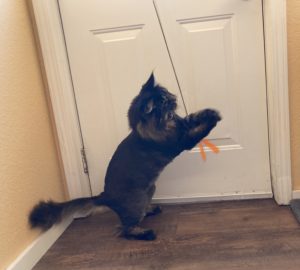Introducing Cats: a Short Guide
Did you know that cat litter was invented by Edward Lowe in 1947? If you check out Wikipedia, you’ll find that he successfully marketed a clay material called Fuller’s Earth as cat box filler. Voilà, the cat moved indoors and into our hearts!
Why own a cat?
- Cats don’t require much space
- They don’t have to HAVE to be walked (thanks to Edward Lowe!)
- They can handle “alone time” fairly well
- They don’t bark and bother the neighbors
About the Domestic Cat, Felis Catus…
The domestic cat is descended from the Middle Eastern wildcat, Felis Lybica, a solitary hunter. About 10,000 years ago, some wildcats chose to take advantage of the abundance of food near human settlements and started to live in groups called “colonies”. The core of the cat colony is the mother cat, her sisters, and her daughters. Male cats tend to leave the colony at puberty to become solitary hunters or affiliate themselves with another unrelated colony.
Getting Ready : Setting up the Multi-cat Household
- Certain cats may become “bonded” – they will groom each other and sleep together. These cats are more tolerant of sharing resources: food, water, litter boxes. Social Groups of Cats
- Multi-cat = multiple resources: multiple feeding stations, multiple water stations, and multiple litter boxes, in addition to multiple sleeping and resting places. Spread these throughout the house, don’t cluster them together. Make sure these are where the cats will use them – for example, have a litter box station on each floor of a multi-story house.
- Have a time sharing system for the common areas – cats in outdoor colonies manage their resources this way. When one group of cats is in the common area, the others are in another area of the house. Often, cats will set this up themselves.
- Establish a regular time for human-cat interaction (playtime, cuddling, hanging out) for all groups of cats.
- Be aware that urine marking and scratching are natural behaviors that allow cats to communicate with each other. (This may require intervention if it becomes a problem).
Homework: A House Plan
Draw a diagram of your house and plan where you will locate resources: litter trays, feeding stations, water stations, scratching posts. Locate these so that all cats can access them at one time or another. Allow cats enough room to avoid each other.

INTRODUCING CATS: STEP-BY-STEP
TAKE YOUR TIME – DO NOT RUSH THINGS.

- STEP 1:
House newcomer in a separate room with all his resources until he is comfortable. - Since cats respond to and communicate by scent, exchange articles of bedding that has the newcomer’s scent on it with bedding with scents from the resident cats.
- Keep the cats from seeing each other during this time.

STEP 2:
Once the cats seem comfortable with each other’s scents (they ignore the bedding or sit on it themselves), allow the newcomer opportunities to explore the common area while the resident cats are not there. Allow the resident cats to check out the newcomer’s place.

STEP 3:
Progress to offering treats and playing with toys on either side of a closed door – the newcomer on one side, the residents on the other.
Use high-value treats to make these visits positive! Continue to feed your cats their regular meals where they are accustomed to eating.

STEP 4: Open the door!
The next step is to secure the door ajar by hooks or doorstops or use a gadget called a Door Buddy (keep it closed enough that the cats can’t get through).
You may prefer to use a screen, baby gate or other fence-like barrier with the cats playing and enjoying treats on either side. A blanket or sheet over the barrier can block the cats from seeing each other if needed.
This step works best with 2 people. Each person will supervise one cat.
The barrier in the photo was built using the instructions on https://pethelpful.com.

STEP 5: Supervised interactions
- Have a sturdy sheet of cardboard that you can separate fighting felines with.
- A large towel or blanket can be used to cover a fractious cat so that the other one can get away.
- “The Stare” is a big part of the cat fight – blocking the cats from seeing each other can help diffuse hostilities.
- This encounter should be “one-on-one”, with the newcomer and one other cat.
- If the cats are harness-trained, it may be helpful to have each cat on a harness and leash at first.
- The next steps are gradually allowing two cats together for longer periods of time – supervision is a must!

TIP: Move on to the next step only when you feel the cats are ready – if hissing, grumbling, or aggression surfaces, separate the cats and go back to the previous step.
Watch for signs of passive aggression: staring, blocking access to litter boxes, food and water.
INTRODUCING CATS takes patience, perseverance and time!
introducing cats – Ensure there is a healthy environment for EACH cat
- A safe place for each cat – this may be a high shelf or cat tree or his/her own room
- Multiple and separate resources (litter trays, scratching posts, feeding and water stations) spread throughout the house
- Consistent, regular human interaction – play and treat time at the same time each day
- Opportunity to exercise hunting skills through play. Playtime and toys can be used to redirect inter-cat aggression.
- Respect the cat’s sense of smell. Repeat scent exchange and segregation when cats have been separated (eg. returning home from the veterinary clinic); use pheromone therapy when appropriate.
Click here to access the Environmental Needs Guidelines
A FINAL WORD…
Introducing cats and managing a multi-cat household is a balancing act. Imagine if YOU arrived home with a complete stranger and announced to your family that this person is now living with you permanently! Cats may or may not become fast friends – we may have to settle for a separate but peaceful coexistence.
Need more information? Have questions? Contact The Feline Purrspective!

